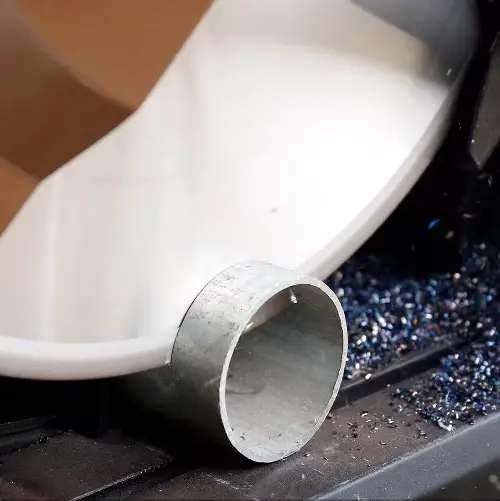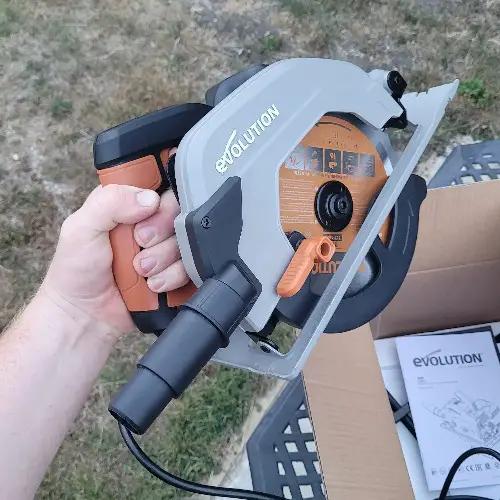You may wonder if you can cut PVC with a circular saw. The answer is, that it depends. PVC is a versatile material that can be sliced with a circular saw, jigsaw, or any other type of saw. Just make sure the blade is sharp and the saw is properly adjusted for the thickness of the PVC otherwise it may cause the PVC to chip or crack.
In this blog post, we will discuss how to cut PVC with a circular saw and some of the factors you need to consider before getting started. So if you want to learn more about this topic, keep reading this blog.
Is it possible to cut PVC with a circular saw?
Yes, it is possible to cut PVC with a circular saw. However, it is recommended that you use a saw with a blade that is specifically designed for cutting PVC. This will help to ensure a clean, straight cut. Also, be sure to wear eye protection and gloves when working with PVC, as it can create dust and debris that can be harmful if inhaled or ingested.
Factors you should consider while cutting PVC with a circular saw:
When cutting PVC with a circular saw, you should consider the following factors:
1. Depth of the cut:
You’ll need to know the depth of the cut to set your saw blade correctly. If you’re not sure, it’s better to err on the side of making a shallower cut than a deeper one. This is because a deeper cut is more likely to cause the PVC to crack.
2. Type of saw blade:

Ensure that you’re using a saw blade that’s designed for cutting PVC. Some common types of saw blades include crosscut blades, rip blades, and combination blades. If you’re not sure which type of blade to use, consult the saw blade manufacturer or your local hardware store.
3. Cutting speed:
PVC can be tough to cut through, so you’ll need to work at a slower cutting speed than you would for other materials. Moreover, this will help to prevent the saw from overheating. In case you’re operating a corded saw, make sure not to put too much strain on the motor by operating too slowly.
4. Safety:
Wear safety goggles when operating a circular saw. In addition, be careful to keep your fingers away from the blade at all times because the saw can kick back unexpectedly. Keep the saw’s guard in place to prevent injuries.
5. Make sure your saw has enough power:

PVC is a tough material, so you’ll need a saw with enough power to cut through it. A circular saw is a reliable option, as it can easily handle thick PVC. Consider upgrading to a more powerful saw if your saw isn’t powerful or adequate. You can easily find powerful circular saws at any hardware store.
How to cut PVC with a circular saw: Step-By-Step Guide:
Cutting PVC pipes with a circular saw can be done in easy different steps, take a look at them:
Step 1: Setting up the saw:
Start by powering up the saw. Make sure that the saw is unplugged before doing anything. Set the blade depth to half an inch. This will make sure that you don’t dig too deep into the pipe and damage it.
Step 2: Marking the cutting line:
Once the saw is all geared up, it’s time to trace the sawing line on the pipe. Make sure that the line is straight and use a pencil or a marker to mark it.
Step 3: Cutting the pipe:
Now, it’s time to trim the pipe. Start the saw and slowly guide it along the cutting line. Make sure that you’re following the line as closely as possible. Once the cut is complete, stop the saw and unplug it.
Step 4: Cleaning up the edges:
Once the pipe is trimmed, you’ll need to clean up the edges. Use a file or sandpaper to smooth out the edges. This will make it easier to connect the two pieces of pipe.
Why is it a good idea to cut PVC with a circular saw?
PVC is a durable and versatile material that can be used for a variety of purposes, including plumbing, piping, and siding. It is also relatively simple to trim, which makes it a suitable choice for DIY projects.
Different methods can be used to cut PVC, but using a circular saw is a quick and convenient method that will give you clean, straight cuts. Here are a few reasons why a circular saw is a suitable choice for cutting PVC:
1. Fast:
A circular saw can quickly slash through PVC, which is helpful if you’re working on a time-sensitive project. Whenever possible, it’s preferable to perform all of your cuts before you start assembling your project. This will help you avoid having to make any last-minute adjustments.
2. Accurate:
If you’re working with PVC pipe or siding, it’s critical to make precise cuts to avoid any leaks. A circular saw can help you create clean, straight cuts that will fit together perfectly.
3. Easy to use:
Cutting PVC with a circular saw is relatively easy, even for beginners. Just be sure to select a sharp blade and follow the manufacturer’s instructions for your saw. In addition, you should wear safety goggles and gloves to protect yourself from the sharp edges of the PVC.
4. Versatile:
A circular saw can be used to produce a variety of different cuts, including straight, angled, and curved cuts. This makes it a suitable choice for projects that require different types of cuts. People often use a jigsaw for curved cuts, but a circular saw can also be utilized for this purpose.
How to measure PVC while cutting with a circular saw?
There are a few different ways that you can measure PVC while cutting with a circular saw:
Method 1: Use a ruler or yardstick
Using a ruler or yardstick is another easy way to measure PVC while cutting with a circular saw. All you need to do is line up the edge of the PVC with the edge of the ruler or yardstick. Then, make a mark at the desired length. Mark your mark and align your saw blade with it. Cut once you have done so.
Method 2: Use a tape measure
If you have a tape measure on hand, you can also use this to measure PVC while cutting with a circular saw. Simply extend the tape measure out to the desired length, and then make a mark on the PVC at that point. Again, simply line up the blade of the saw with the mark and make your cut.
Method 3: Use a laser level
When you want to be precise with your cuts, you can use a laser level to help you measure PVC while cutting with a circular saw. This is a very beneficial option if you have one available, as it will allow you to get a perfectly straight cut every time. Simply line up the laser level with the edge of the PVC, and then make your mark at the desired length.
FAQs:
1. Can I use a regular saw blade to cut PVC?
Yes, you can use a regular saw blade to cut PVC. However, it’s critical to use a sharp blade to avoid any damage to the PVC. A dull blade can cause the PVC to crack or break.
2. What is the right way to cut PVC pipe?
There are a variety of ways that you can cut PVC pipe. Circular saws, on the other hand, will give you clean, straight cuts quickly and easily.
3. What should I keep in mind when cutting PVC with a circular saw?
When using a circular saw to cut PVC, you should bear a few things in mind. To start with, always use a scalpel edge to prevent PVC from being damaged. Second, protect yourself from the sharp edges of PVC by wearing safety gloves and a mask. Finally, be sure to set up your saw according to the manufacturer’s instructions.
4. Can I use a circular saw to make curved cuts in PVC?
Yes, you can use a circular saw to make curved cuts in PVC. However, it’s crucial to use a sharp blade and to operate your saw as directed by the manufacturer.
Final Verdict:
PVC can be cut with a circular saw because it is simple to use and produces neat, straight cuts. Just make sure you use a sharp blade and use your saw according to the manufacturer’s recommendations. Additionally, it is a smart idea to put on protective goggles and gloves to shield your hands from the PVC’s jagged edges.
In this guide, we have looked at the best way to cut PVC, and how to measure it while you are cutting. We have also looked at some FAQs about cutting PVC. So we hope that you have found this guide helpful.
If you have any questions, please feel free to ask in the comments section below. Also, check out our more informative saws related articles on our website.

I am William Anderson and I’m the founder of this website. I started this site because I was tired of dealing with the problems that come with using Saw Tools. I wanted to help others avoid the time and frustration I had, So I started this site based on my own experience and what I’ve learned from other professionals and resources.